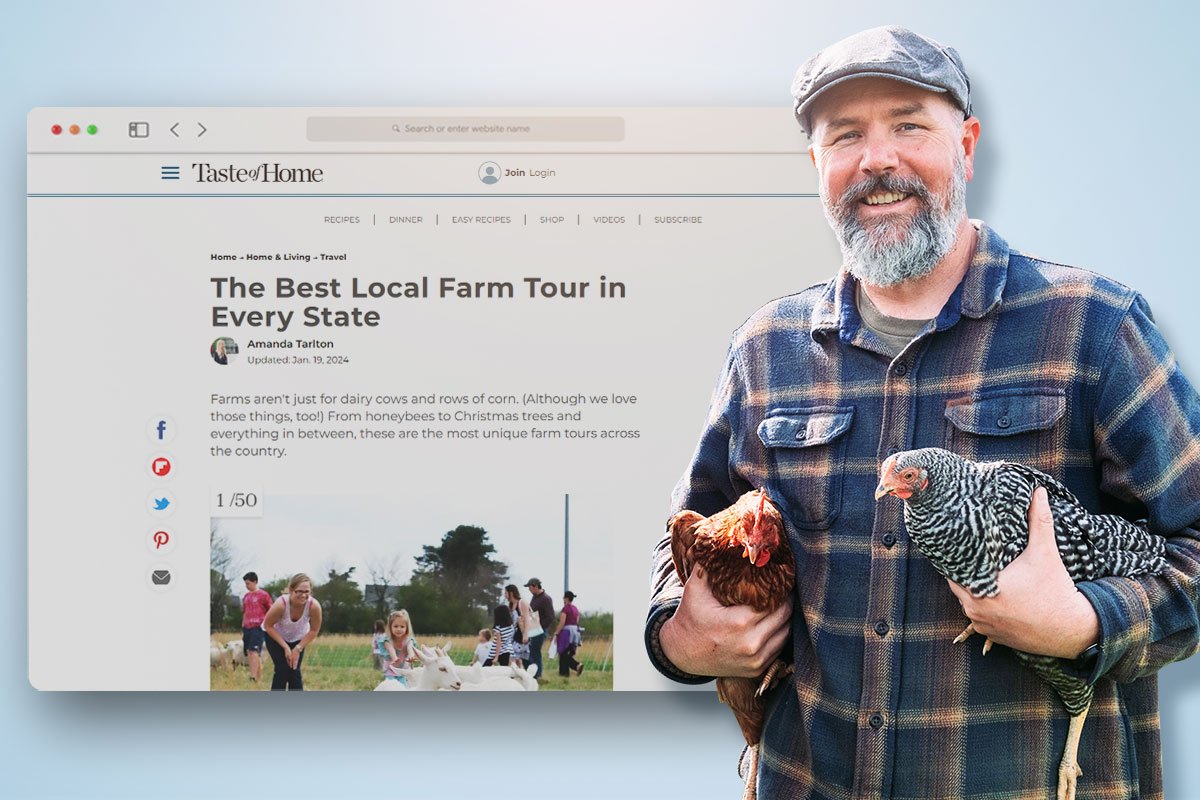Did you know that there are approximately two million U.S. farms, earning a combined $549.8B annually?
That means the average farm makes around $275K per year.
Whether you want to get your hands dirty growing crops or raising livestock, you can make a great living doing it. You can even start a hobby farm to grow food and make some extra money while you do it.
We’ve talked to dairy farmers, fruit farmers, and people raising goats, pigs, chickens, and other animals. These farmers make between $200K and $10M per year. With their guidance, we’re going to share how to start a farm and make a great living.
Farming Business Case Study: Miami Fruit
Rane Roatta started Miami Fruit when he was living with his single mom. His operation started as a family farm whose fruit he sold off the back of his bike. Now he’s selling millions of dollars worth of farm products every year.
He uses social media and an eCommerce site to help educate people about small farms and fruit recipes.
Want to know more? Check out our interview with Rane below to learn how to start farming.
How much does it cost to start a farm?
Farming is also a business, so you need to understand exactly how much it will cost. And it’s a complicated question with no set answer.
However, you can expect to spend anywhere from $600-$10K to start a small-scale farming operation. Large-scale operations can cost well over $2M to start!
To clarify your costs, create a comprehensive list of everything you need. Don’t be afraid to ask for help and advice from your farmer connections.
The costs of starting a farm might surprise you, but consider these essentials:
- Land
- Equipment and machinery
- Business management systems
We’ll discuss each of these later, but first, let’s discuss farmers’ earnings.
How much do farmers make?

That means the average farm makes around $275K per year, according to USDA data.
A farm’s cash flow may not be evenly distributed throughout the year. During the planting season, for instance, there will normally be an outflow of cash or borrowing money. During the growing season, spending may decrease but revenue will remain low.
Come harvest, revenues generally skyrocket while expenses are nominal. During this time, you may also need to pay back farm subsidies that help support agriculture farming throughout the year.
Next, let’s discuss some of the challenges you might experience when you start a farm.
Is owning a farm difficult?
Yes. Farmers and ranchers often experience uncertainty and conflict that put pressure on them during planting and harvesting. Some of the main stressors of farm operations include:
- Maintenance: Farming requires maintaining animals, crops, equipment, and your property. Maintenance can consume time and money quickly.
- Weather: You can’t predict when droughts, heatwaves, floods, freezing weather, tornadoes, or hurricanes strike and wreak havoc on a farm.
- Natural risks: Insects and soil-borne diseases can also make it difficult to run a successful farm business.
- Financial risks: Startup costs are high, market prices fluctuate, and earnings are inconsistent.
- Climate-compatibility: Some crops are just incompatible with local markets. For instance, you can’t grow tropical fruits in the middle of a desert.
- Mental aspects: Stress and mental fatigue can often make a farm operation difficult, especially for beginning farmers.
- Family turmoil: You know the old saying that business and family don’t mix? They almost always do in a farming business and that can cause stress.
Self-financing, crop insurance, and a commitment to dealing with problems head-on can reduce many of the stressors involved in starting a farm business.
What is the most profitable farm to start?
According to Insider Monkey, the source for the top-rated Yahoo blog, the most profitable farms are:
- Corn/Maize: $82.4B
- Soy Beans: $57.6B
- Wheat: $12B
- Tomatoes: $10.5B
- Almonds: $8.5B
You should look at whether these crops are suitable for your area when you consider starting a farm business. Next, let’s look at how to start a farm.
How to Start a Farm

Here are some steps to take to start a farm:
- Identify your niche.
- Learn about farming.
- Research the market.
- Write a business plan.
- Register your farm business.
- Get financing.
- Buy farmland.
- Buy farming equipment.
- Start operations.
- Establish sales and distribution channels.
- Market to your customer base.
Get ready to learn how to start a small farm.
Identify Your Niche
Before starting a farm business, you must choose what kind of small farm you want to run.
There are many options, and each one presents its own pros and cons. You will need to base your choice on a balance of passion (what can I wake up every morning and be happy doing?) and good business sense.
With experience and education, the decision about the type of farm you want to run will be a bit easier.
Remember that while passion is key, it’s essential to consider more than your favorite crop. Understand that farming is a business, and you must know what the market can handle. For example, hemp farmers in Wisconsin hit a bottleneck in their market and ran out of buyers in 2019.
These are some types of farms to consider:
Dairy Farms
Specifically dedicated to the production of milk (typically from cows or goats), a dairy farmer can have as few as one animal and as many as a few thousand. Milk used for drinking will need special equipment to comply with government guidelines.
The Lukens family started their family farm operation with just two goats. Now they make over $120K per month. Here’s part one of our interview with them.
Check out the second part of our interview with them, too.
Your 6-Figure Business Is Calling… |
|
| Whether you’re looking to start a farm or a home service company, you can learn how to make 6 figures with expert guidance from the UpFlip Academy. You’ll gain real-world insights from the likes of Brandon Vaugn, who went from food stamps to $750K a month, and Chris Mondragon, who brings in $140K monthly with his cleaning business! Plus, learn from a community of entrepreneurs and business mentors who can answer any of your startup questions. | |
| Sign up today! | |
Crop Farms
Every month there are more than 3,100 searches for the terms “vegetable farms near me” and “vegetable farm near me.” That’s a pretty good indicator that you should be selling to the public if you are growing fruits, vegetables, or grains.
These farms are dedicated to feeding people. For a small farm, this might mean a diversified list of various crops sold locally at farmers markets or co-ops. Make sure to rotate your crops to maintain the nutrients in the soil and provide healthier food.
Larger farms tend to stick with only one type of crop and may rely on large corporate deals for their produce.
Chicken Farms
Poultry farms (chickens and turkeys) are typically used for meat but may also supply eggs. Many smaller farms featuring cage-free, locally produced poultry and eggs are competing with larger-scale producers.
Check out how Geoff Scott and his partner started Marion Acres, Helvetia Farm Market, and Helvetia Poultry Processing.
Flower Farms
Flower farms supply their products to florists who then sell the product to an end-user. This type of small farm may also sell at farmers markets or to local grocery chains.
Mushroom Farm
Have you considered mushroom farming? If you want to learn how to start a mushroom farm, we’ve got you covered. We interviewed Sundown Hazeen, the owner of Cheesed Farms, who learned how to grow mushrooms and turned it into a six-figure-a-year business.
Organic Farming
Organic farming means that a product meets strict growing, handling, and processing standards. There are two levels of organic products:
- USDA-Certified Products: These products contain at least 95% organic content, go through a 12+ week certification process, and bear the USDA Organic seal.
- “Made With” Organic Materials: These products contain at least 70% organic materials and are mostly a marketing ploy but may still fetch a higher price.
A farm or processing facility must go through a rigorous process to get their products deemed USDA-certified organic products. The steps include:
- Following federal guidelines for soil quality, animal raising, reduction of pests and weeds, and additive use
- Preserving biodiversity, respecting the natural cycles, and caring for animals
- Avoiding GMOs, synthetics, and chemicals, while providing transparency on labels
- Submitting an Organic System Plan
- Allowing an accredited agent to inspect farm operations
- Waiting for a certified agent to review the inspection report
If your products pass the certification process, you can sell them with the coveted “USDA Organic” seal.
Other Interesting Farms
You wouldn’t believe how many types of farms people want to learn about. Some of the most common Google searches are about how to start a:
- Christmas tree farm
- Bee farm
- Mushroom farm
- Cattle farm
- Fish farm
- Lavender farm
- Goat farm
- Crawfish farm
- Shrimp farm
- Hog farm
- Deer farm
- Hydroponic farm
- Sod farm
- Sheep farm
- Butterfly farm
- Petting farm
- Regenerative farm
While this may indicate demand, it’s important to conduct market research to determine whether the above farms are economically viable.
Whether it’s just a hobby or you want to make farm work a small business, there are plenty of opportunities for finding land and starting a farm business. But there will be a learning curve.
Learn About Farming

If you grew up in the concrete jungle, then your first step is getting out of town.
The idea of a farmer wandering around on his property with a wheat stalk sticking out of his mouth isn’t reality. Farming is dirty, smelly, and hard work. It’s not for the faint of heart.
To gain a better understanding, visit the different farm types you might be interested in running and view them from a hands-on standpoint. If you don’t know a farmer, try searching online and scheduling a private tour.
Even better, ask if they’ll let you spend a whole day (or more!) with them to see how everything runs. Farming is a complicated business, so it’s vital to do loads of research on the front end so you know what you’re facing.
Education and Experience
A tour may be educational and inspirational, but it won’t cut it to run a successful farming operation. Farm managers need experience! Fortunately, there are many training programs available in the U.S.
- Rogue Farm Corps
- The Land Connection
- University of Vermont Farmer Training Program (6 months)
- New Entry Sustainable Farming Project
Learning how to become a farmer may be a slow process, but you’ll benefit from spending time on the land and working with real farmers.
Take courses at local universities or community colleges to learn about land preparation, seed propagation, soil fertility, pest control, harvesting, and crop storage.
Make Local Connections
Like many businesses, farms function better when they’re in a community that supports each other. Community Supported Agriculture is a new business model for farming to consider before starting your farm.
The system connects farmers to locals who can become subscribers. In return, they receive a weekly delivery of produce or other goods from the farm. Farmers regularly update subscribers on the status of the farm and invite them for on-site tours.
As a newcomer to the farming industry, you can get involved in this model to not only gain investors in your own farm but to learn from and cultivate relationships with other local farmers.
Connect to one of these farming communities through local relationships, farmers markets, or by finding one online.
Conduct Market Research
You’ll need to understand land preparation, seed propagation, soil fertility, pest control, harvesting, and crop storage.
Just growing things isn’t enough to make a farm successful.
Like any business, you must conduct a thorough market analysis and match your crop to your customer base. According to Tim Lukens, finding your customer base is one of the most critical aspects of running a viable farming business. You need to know who will buy your products.
Researching the market where you want to sell your products will give you an idea of what type of marketing budget you’ll need once your farm is up and running. If you are selling food, then keeping the market local can be beneficial, but don’t rule out the online marketplace.
The United States Department of Agriculture (USDA) is the top source for agricultural market research and has extensive resources available for free.
Case Study: Grace Harbor’s Growing Customer Base
For Grace Harbor’s business, the customer base developed over time. Since she started with goats, the natural progression for Grace Harbor was to make soap and then lotions. Her business began at farmers markets and moved to a mall kiosk to sell its goods.
Demand continued to increase, and now over 100 stores nationwide carry her skincare products.
The Lukens also began selling their soaps and other skincare products online, which is where their largest market is today.
The Washington State Department of Agriculture offers resources to help local farms market their products, providing marketing guidance, regulation education, and training specifically for small, local farms. Oregon has a similar program for those with a small farming business.
A quick online search will reveal assistance programs if you are starting a farm in another state.
Write a Business Plan
To understand if your farm is viable as a business, you need a business plan.
Your business plan is a “roadmap to success.” It provides information about who you are, what you want, and how you intend to get there. It’s a set of guidelines and is subject to change, but it’s a good place to start your journey towards becoming a farmer.
Fortunately, the USDA offers assistance in creating a business plan along with other resources to farmers who are just starting.
Other Resources
- New England Small Farm Institute’s sample business plan resources for farmers
- North Carolina State’s organic farm planning resources
- Kansas State Ag Manager’s sample business plan
- Small farm business plan sample
Register Your Farm Business

Registering your farm helps with income tax and securing funding, and it looks more professional to investors. You’ll want to choose a farm business name.
To legally start your farming operation, you need to establish a business structure for legal and tax purposes. Like any business, farmers operate under one of five structures: limited liability company, sole proprietorship, corporation, partnership, or cooperative.
Permits and Licenses
Besides a business structure, your farm will require various permits and licenses based on your location and style of farm.
The USDA has an online resource that maps out the federal licenses for each farm type. However, you must visit your state’s Department of Agriculture site to check on state and local licenses and permits.
Farmers Business Insurance
There are a variety of insurance policies that you should consider including:
- Crop insurance: There are all kinds of crop and livestock insurance available through the USDA Risk Management Agency
- Farmstead insurance: This is often called farm and ranch insurance. It works like homeowners insurance but covers more than a typical homeowners policy. You’ll also be able to get add-ons like livestock or crop insurance.
You can compare quotes from the major business insurance companies with Simply Business.
Get Financing
Once you complete a business plan and understand the feasibility of your agriculture business, it’s time to organize your finances. Although taking out loans to start a farm can be challenging, you may find it unavoidable.
Securing financing like loans, grants, or investment partners can help with startup costs, working capital, expansion, and growth.
Conventional Loans, the USDA, and Other Options
Traditional bank loans and small business loans may be available for your farm business. However, without some collateral or previous business history, they may be difficult to secure.
The best resource for a small farm loan (and for all things related to agriculture in the U.S.) is the USDA. The U.S. government aids farming operations of any size through their beginning farmer and rancher loans.
There are thousands of local USDA service centers throughout the country available to help with farming business needs.
Many people who don’t have startup capital may find help from family or friends, grant opportunities (make sure your business plan is solid!), or even the use of a 0% credit card.
You can apply to get up to a $50K loan from Borrow Nation.
Avoid Debt
While you might need a bit of money upfront to get started, many farmers suggest that those starting a farm business avoid getting into debt.
The Lukens family learned this the hard way when a bout of E. coli found its way into their product line. Health officials traced the bacteria back to Grace Harbor when someone became ill. The farm took a financial nosedive overnight. They tried to rely on credit cards to bail themselves out but ended up declaring bankruptcy.
After this disappointing situation, the Lukens regrouped by using only cash reserves to pay for operations. They learned a very hard lesson about avoiding debt at all costs.
Advice from Chris Hogan, formerly of Ramsey Solutions, states that debt can magnify problems, and entrepreneurs need to keep a close eye on cash flow.
Buy Farmland

Obviously, you need a parcel of land to grow your food or keep your animals. If you already have property, you could start a small farm in your own backyard. If you need to buy or rent land, factor that into your startup costs.
Buy Farming Equipment

You’ll need to buy farming equipment. Your farmer tools depend on the type of farm you run.
Large crops may require tractors and storage buildings, among other equipment. Dairy farms may require special milking and pasteurizing equipment. Animals require fences, outbuildings, and a variety of handling equipment.
If you’re making products on-site, like Grace Harbor’s skincare line, you need a manufacturing space for production equipment and labeling.
It may be possible to borrow or share equipment at the beginning, which is a great way to keep your costs low. This is where those connections with other farmers continue to come into play.
Farm workers might also need to purchase:
- Water pumps
- Soil preparation
- Seeds
- Irrigation
- Cooling and storage
- Packaging
- Marketing
- Animals and veterinary services (if running a farm with animals)
If farming sounds like it will be too costly, check out some of the most profitable businesses.
Start Operations
Once you have all the equipment, crops, and livestock, it’s time to run your business. That means you’ll need to:
- Care for crops or livestock: This might mean hiring farm workers. Learn more about hiring.
- Manage financials: Use QuickBooks, Easy Farm, or Farmbooks.
Go to Farmers Markets and Other Sales Channels
Based on our interviews about how to start a small farm business, there are several sales and distribution channels you should consider.
- On-premises: You can sell your products directly to consumers at your location. This requires marketing your farm but no shipping.
- eCommerce: Sell your products online and ship them to customers.
- Farmers markets: The USDA has a national farmers market directory where you can find your local market, contact the director, and negotiate your way into the market.
- Distributors: Sell your cattle or food to distributors that will transport it to grocery stores and other locations.
The distribution channels you choose will impact your profitability, but most successful farm businesses will use multiple channels.
Go Start Your Successful Farm Business
We’ve discussed the farm industry, farm ideas, how to start a farm, business structures, how to buy a farm, and where to sell farm produce and meat. It’s up to you to take the information, turn it into a farm business plan, then enact it.
One thing farmers need to understand to be successful is who their buyers are. Tim Lukens says:
Lukens says that a farmer needs to understand what the market potential is and understand what the operating costs are. This will help protect those who want to start a farm business from getting in over their heads.
Are you ready to get started on your own farm? Let’s hear what you’re going to be raising or growing on your very own land!
Launch Your Farm With Support From UpFlip Academy |
|
| Starting a farm is a huge undertaking. UpFlip Academy offers over 500 business ideas, a vibrant founders community, and insights from successful entrepreneurs to help you reach your farming business goals that much more efficiently. | |
| Get going with the Academy today! | |








